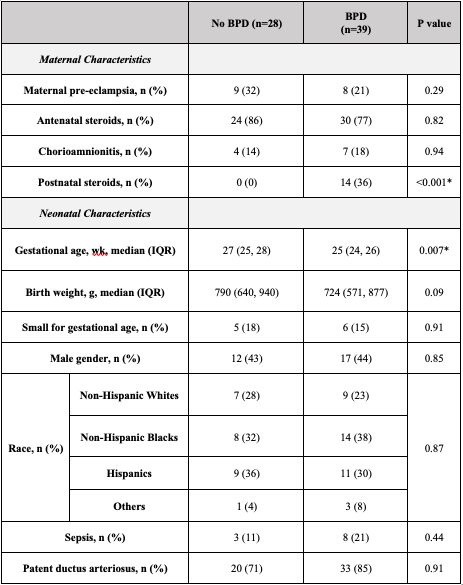Back
Genomics/Epigenomics
Category: Abstract Submission
1: Genomics/Epigenomics I
4 - Gene Variant of Hippo Pathway Associated with BPD Susceptibility in ELBW Infants
Friday, April 22, 2022
6:15 PM – 8:45 PM US MT
Poster Number: 4
Publication Number: 4.109
Publication Number: 4.109
Nisha Palla, New York Medical College, Dix HIlls, NY, United States; Van Y. Trinh, New York Medical College, Valhalla, NY, United States; Lance Parton, MFCH at WMC, NYMC, BCHP, Valhalla, NY, United States
- NP
Nisha Palla, BA
Medical Student
New York Medical College
Dix HIlls, New York, United States
Presenting Author(s)
Background: Bronchopulmonary dysplasia (BPD) is one of the most common causes of death and morbidity in extremely low birth weight (ELBW) infants. It is characterized by exposure to environmental stimuli such as: mechanical ventilation-pressure, volume; hyperoxia; and inflammation; within a background of genetic susceptibility. Impaired lung development affects the respiratory epithelium, the vascular endothelium, and the extracellular matrix. The Hippo signaling pathway is known to play a key role in tissue growth suppression and modulation in lung development, physiology, and injury. Specifically, variants of yes-associated protein (YAP), transcriptional co-activator with PDZ-binding motif (TAZ) and transcription enhancer factor (TEA/ATTS) domain (TEAD) are important regulators of the Hippo pathway and are associated with changes in lung function in asthma and in small-cell lung cancer. Perturbations to YAP, TAZ and TEAD of the Hippo pathway result in altered pulmonary tissue growth and vascular development. Because alterations in pulmonary lung and vascular development are also characteristic of BPD, we hypothesize that genetic variants in YAP, TAZ and TEAD of the Hippo pathway are associated with the development of BPD in ELBW infants
Objective: The aim of this study is to identify genomic variants in the Hippo YAP/TAZ signaling pathway that alter susceptibility to BPD in preterm infants.
Design/Methods: DNA extracted from buccal swabs collected from ELBW infants following IRB-approved parental consent was subjected to allelic discrimination using specific Taqman probes for rs10895256, rs2846836, rs1820453, rs16861979, rs2304733, rs6918698 and rs11225163 during RT-PCR. Statistics included Chi-square, t-test, and z-test, with significant p value ≤0.05.
Results: Demographic characteristics did not differ between those with BPD and those without BPD except for gestational age and postnatal steroids (Table 1). TEAD variant rs2304733 was found to have a significantly different genotype distribution in the BPD group compared to the Non-BPD group (p=0.05) (Table 2). There were no statistical differences in the genotype distributions of the other YAP1 or TAZ variants tested. Conclusion(s): The TEAD variant rs2304733 is associated with BPD in ELBW infants. We speculate that while preterm birth perturbs the HIPPO pathway and accelerates pulmonary growth suppression, this specific TEAD genetic variant may play a role in modulating YAP/TAZ nuclear localization, contributing to increased susceptibility to BPD.
Table 1. Demographic or TEAD SNP rs2304733 for infants with and without BPD
Table 2. Genotype distribution for TEAD SNP rs2304733 for infants with and without BPD (*p=0.05). +Minor allele frequency from 1000 Genomes.png)
Objective: The aim of this study is to identify genomic variants in the Hippo YAP/TAZ signaling pathway that alter susceptibility to BPD in preterm infants.
Design/Methods: DNA extracted from buccal swabs collected from ELBW infants following IRB-approved parental consent was subjected to allelic discrimination using specific Taqman probes for rs10895256, rs2846836, rs1820453, rs16861979, rs2304733, rs6918698 and rs11225163 during RT-PCR. Statistics included Chi-square, t-test, and z-test, with significant p value ≤0.05.
Results: Demographic characteristics did not differ between those with BPD and those without BPD except for gestational age and postnatal steroids (Table 1). TEAD variant rs2304733 was found to have a significantly different genotype distribution in the BPD group compared to the Non-BPD group (p=0.05) (Table 2). There were no statistical differences in the genotype distributions of the other YAP1 or TAZ variants tested. Conclusion(s): The TEAD variant rs2304733 is associated with BPD in ELBW infants. We speculate that while preterm birth perturbs the HIPPO pathway and accelerates pulmonary growth suppression, this specific TEAD genetic variant may play a role in modulating YAP/TAZ nuclear localization, contributing to increased susceptibility to BPD.
Table 1. Demographic or TEAD SNP rs2304733 for infants with and without BPD

Table 2. Genotype distribution for TEAD SNP rs2304733 for infants with and without BPD (*p=0.05). +Minor allele frequency from 1000 Genomes
.png)
